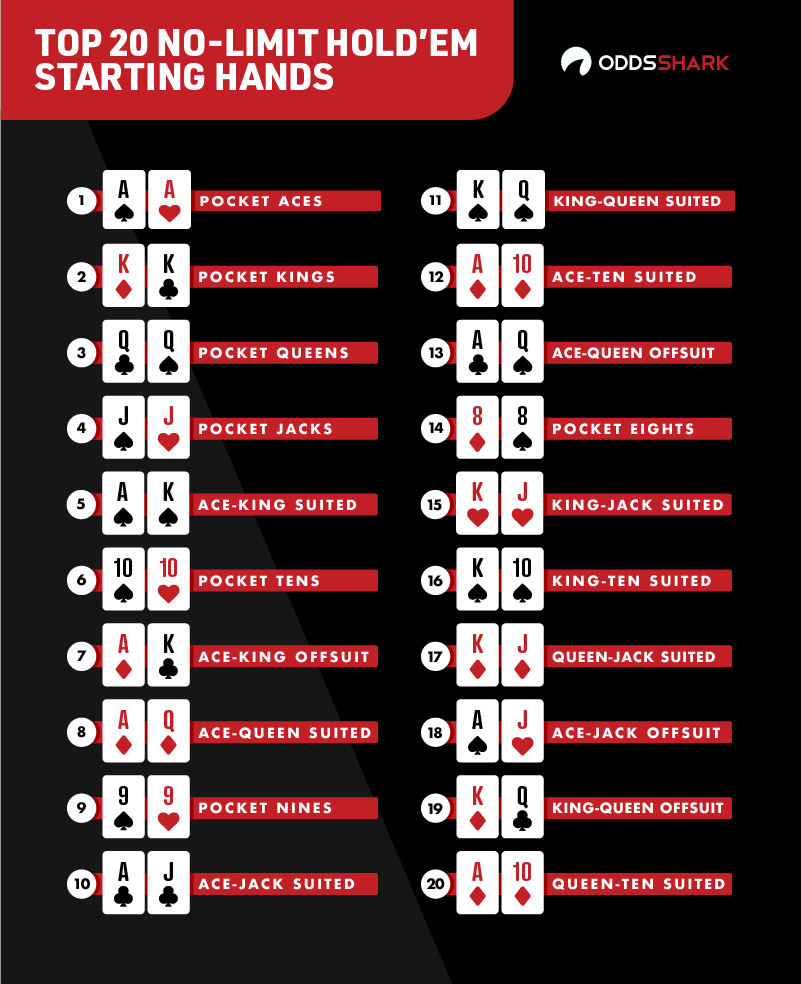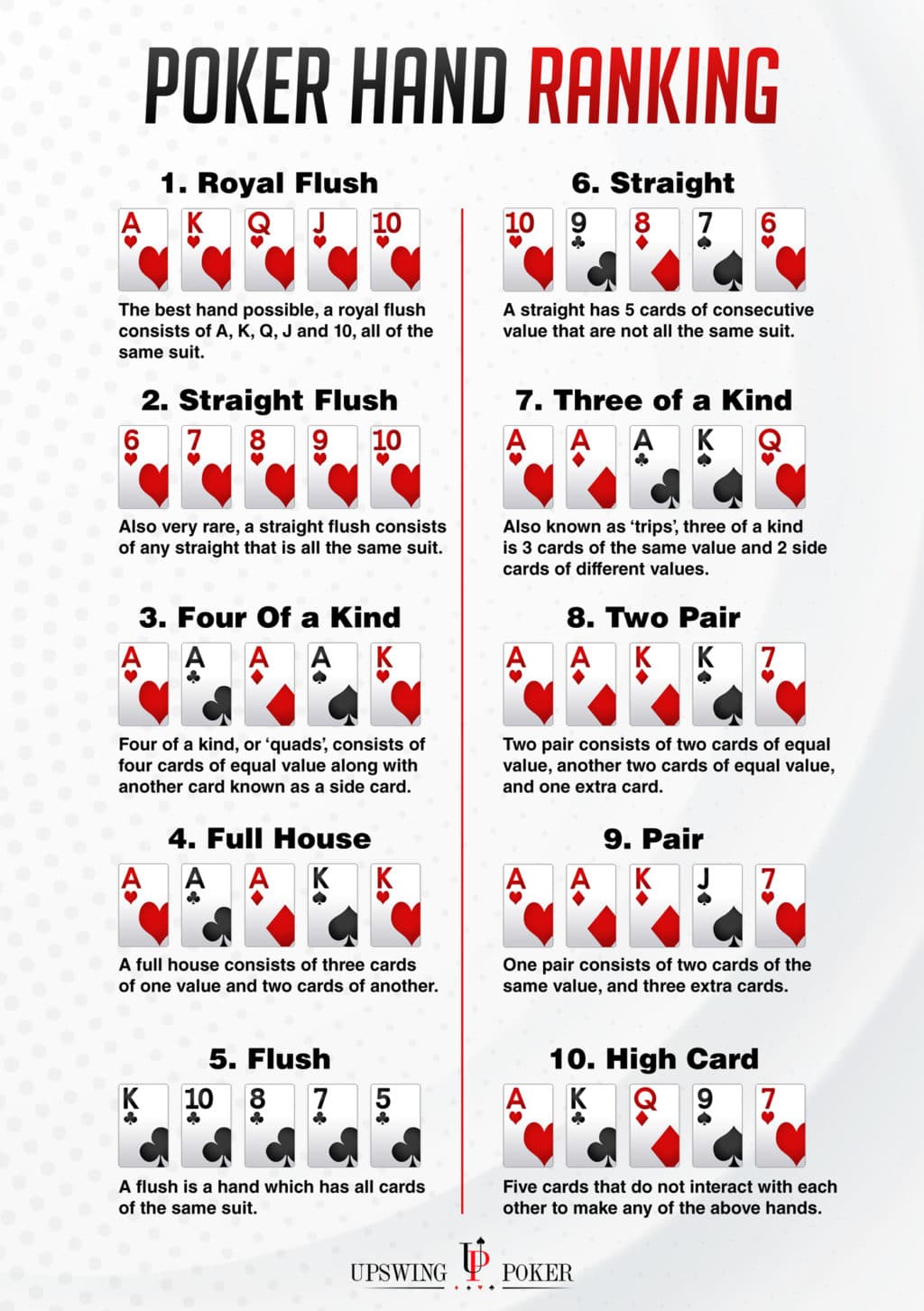Which Hands Beat What In Poker
Poker The best way to remember what hands beat is by placing which hands have the highest hands at the end of the turn. If you can memorize that quickly, you have a leg up on the competition because some players are known to be weak early in the game, but they make up for it later in the game. Print out this free poker hand rankings chart – and always know the best winning poker hands. Poker hands are ranked in order from best to worst. Royal Flush An ace high straight flush. Straight Flush Five consecutive cards in the same suit. Four of a Kind Four cards of the same rank. The simplest definition of a bad beat is when a poker hand that is a favorite to win, loses to an underdog hand that catches up and beats it. Let’s say for example, in a typical no-limit hold’em game or no-limit hold’em tournament, you go all-in before the flop with the best possible hand at that moment: Ace, Ace.
The is the best possible hand you can get in standard five-card Poker is called a royal. A Flush is among the strongest hands in Texas Holdem since it beats most hands and is beaten by a few hands. When a hand has 5 cards of a similar suit, it is called a 'Flush.' Some hands that can defeat a flush include a full house (also called a 'boat') which comprises five cards made up of 3-of-a-kind and a pair.
Use the list of poker hand rankings below to instantly know what beats what in poker for any particular hand you might be dealing with. Commit this poker hand ranking list into memory now and if you need it, print it out (there is a button on the right bottom). Knowing the correct poker hand ranking is crucial to begin making a winning poker hand immediately. Once you can get a grip on a hand ranking system, then you will know what kind of bets you should be making in any writing you might be dealing with, so you can increase your bankroll and win more poker tournaments.
There are three types of poker hand rankings: pre-flop, post-flop, and flop. The pre-flop hands are the highest valued cards in the player’s hand before the turn, pre-flop, flop, post-flop. Post-flop hands are the second highest valued cards in the player’s hand after the turn. High card hands rank after the loss and before the turn, also known as post position, and they are valued higher than the flop position.
To get a good idea of what beats what in poker for each hand you are dealing with, we need to go over the poker hand rankings charts. poker The best way to remember what hands beat is by placing which hands have the highest hands at the end of the turn. If you can memorize that quickly, you have a leg up on the competition because some players are known to be weak early in the game, but they make up for it later in the game. You will want to memorize pre-flop hands, post-flop hands, and flop hands and keep them in front of your eyes at all times when you play poker.
What makes what beats what in poker even more impressive is whether the hands hit the other two in consecutive games. The two highest hands usually beat the two lowest hands in successive games. In the multi-game play, the highest kicker is generally worth at least three to four points against the next highest kicker in a two-game set. So if two players have a hand that is worth three to four points in pre-flop money, they are worth two to three points each in post-flop action. This makes what beats what in poker even more interesting because there are so many possibilities for each player.
For example, let’s say that Jack and Jill are both playing strong hands in pre-flop action. Jack has a strong hand pre-flop and then bets out raising his pre-flop hand to ten big money. Jill calls and folds on the flop and then bets out again, raising her pre-flop hand to fourteen. Now we will wait for Jack to fold or call after both raises.
What beats what in poker hand rankings is simply consistency. If a player is consistent with raising and betting out large hands and calling or folding weak hands consistently, their hand ranking will be compatible. However, sometimes this is not enough, and the player must study the game and analyze where their low draws and poor decisions come from. Many times these problems can be solved by gaining a better understanding of the general poker rules.
:max_bytes(150000):strip_icc()/best-starting-hands-texas-hold-em-412253_final-6f77b6e535ed49dd81ecb6edfb536b81.png)
- »News
- »How To Confuse and Beat Good Poker Players
What Beats What In Poker
Playing poker against opponents who are lesser-skilled than you is a recipe for success. Not all your opponents are weak, however, there are some very good poker players out there. These stronger players are not limited to high-stakes games, good poker players frequent even the low and micro-stakes.
It is easier to win against weak players. They do not think deep enough about the game to warrant any out-of-the-box thinking. Value bet when you have the good, fold when they show strength, and you will not go far wrong.
Beating good poker players requires more creativity. They are less likely to pay you off and more likely to put you in tricky spots. Good poker players are more observant, meaning they pick up on betting patterns and tells. You need to be on your game to beat these opponents and beat them consistently.
Keep Good Poker Players Guessing By Mixing Up Your Continuation Bets
We spoke about continuation bets only a week or so ago. They are a powerful tool that every poker player has in their arsenal. Mixing up when you continuation bet and when you do not is one way to confuse good poker players.
Let us take a look at a simple example. We raise preflop with As-Kc and one opponent called. The flop comes down Kd-5c-2s, what do you do? Your first instinct is to continuation bet, but doing this 100% of the time makes you easier to read. Good poker players will stop paying you off. Instead of automatically making a c-bet, consider checking and reevaluating once our opponent acts. Keeping opponents second-guessing themselves is a great way to dominate them.
Consider Slow Playing Big Hands Against Good Poker Players
Few poker players suggest slow-playing big hands preflop, but it is a necessary evil. It is tempting to always three-bet with aces, kings, and queens, and do so for value. Think about just calling when the raises come from good poker players.
Stronger opponents raise with a wider range of hands, hands that they do not want to play in a three-bet pot. They fold a large percentage of their raising range, which leaves you to collect a small pot.
Do not always flat call their raise with a monster, but be prepared to do so. Just calling with strong hands preflop keeps your opponent wondering what you have. They never, initially at least, think you called with pocket kings, for example. Once good poker players know you are capable of flat-calling with big hands, it opens to door to other opportunities. They do not know if you have called with As-Ac or 9d-7d. Likewise, your three-bets could be with anything if you are prepared to only call with a monster!
Do Not Only Raise With Strong Hands and Draws
Lower-stakes players play a more straightforward form of poker. Their raises tend to mean they have an overpair to the board, at least two pair or a set, or a big draw with plenty of outs. Remember our article about playing draws aggressively?
Mix up the hands you raise with and include both bluffs and semi-bluffs. Consider raising the flop with two overcards, for example, raising As-Ks on a Td-6c-3s flop. Raise it up with an inside straight draw occasionally. Good poker players take notes on what they see so the next time you raise on the flop they wonder what on Earth you could hold. Your chances of making money increase when your opponent does not know what to do.

Use a Standard Time For Acting and Watch Your Bet Sizes

Avoid giving off timing tells, especially in the online poker world, by always taking the same amount of time to act. A quick check is almost always the sign of a weak hand. Conversely, a fast bet is almost always a display of strength. Choose a number and wait until you count to it before acting. Keeping your time to act standardized prevents opponents from getting reads from you.
Similar is said for bet sizing. Weaker players bet bigger with strong, made hands, and smaller with bluff and draws. Good poker players mix their bets up, No-Limit Hold’em is “no limit” after all; you can bet what you like!
Which Hands Beat What In Poker Terms
Always bet the maximum that a recreational player will call. These opponents call you off lightly so extracting value from them is a must. Mix things up against good poker players by sometimes betting small/large with big hands or bluff. Keep them second-guessing and wondering what is happening at their table.